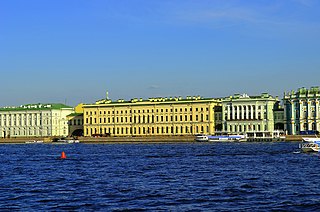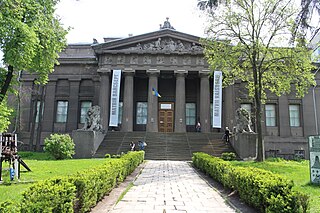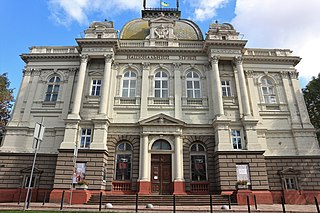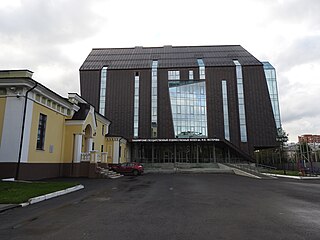
Poltava Art Museum is a public art gallery in Poltava, Ukraine which contains many works of native and foreign art and a rich ethnographic collection.

Poltava Art Museum is a public art gallery in Poltava, Ukraine which contains many works of native and foreign art and a rich ethnographic collection.
Today’s collection of the museum was started in 1917, when Nikolai Yaroshenko, a painter who belonged to the Association of Itinerants (‘Peredvizhniki’), donated his art collection to his native city. As well as 100 paintings and 23 sketchbooks created by Yaroshenko himself, his collection included works by his friends and colleagues who took part in the Itinerant Art Exhibitions: Ivan Shishkin, Vasily Polenov, Vladimir Makovsky, Ilya Repin, Vasily Maksimov and others.
The Museum was opened to the public on April 27, 1919. Originally it was officially an art gallery, not a real museum. Its founder Mikhail Rudynsky, who later became a famous Ukrainian archaeologist and museologist, called it “The Museum of Arts”.
It was decided to establish a city museum after Poltava region’s Historic and Artistic Monuments Protection Committee was created in the city. The artistic objects from the nationalised estates of the Kochubeys (in Dykanka), the Galagans (in Sokyrnytsi), the Kapnists (in Obukhivka), the Repnins (in Yahotyn) were now in public ownership. The museum was located in the mansion which had belonged to the landowner Bolyubash. It had been built in 1912 (the design was by the famous architect Aleshin) in a quiet corner of Poltava at 11, Spasskaya street.
In a year and a half, the museum became an art department of the present Local History Museum. From 1934, after liquidation of the museum had been proposed, it was relocated in the building of the Local History Museum, where it occupied nine rooms on the ground floor. On March 7, 1939, the Council of People's Commissars decreed its independent status as a regional art museum.
Shortly before the war, the collection numbered about 30,000 museum pieces. During the Nazi occupation, nearly all the objects that had been on display were ruined and lost. Only the evacuated treasures of the museum survived. The museum records were lost too. Nowadays, it is only due to the museum guide by Rudynsky that we can imagine how great the losses were: a rich collection of Western European paintings by Giovanni Battista Tiepolo, Peter Paul Rubens, Melchior d'Hondecoeter, Adriaen van Ostade, Élisabeth Louise Vigée-Le Brun and others, works by Ukrainian painters of the 17th-18th centuries, the best pieces by Russian artists of the 19th-20th centuries, to name but a few. [1] In November 1944, when Poltava was still all ruined, the Art Museum resumed its work.
In 1951, the museum returned to its original building that had been restored. After the war, the staff of the museum did their best to make up the lost collection. Now, including the 4,187 objects that survived in the war, it numbered over 9,000 museum pieces. However, the building, somewhat hastily repaired, was in bad technical condition (as it was stated in 2000). The City Council resolved to move the museum to the building of the Art Gallery in Frunze Street. There, the exhibition takes up two separate suites of rooms on the ground floor.
After the relocation, the chronological arrangement of the exhibition remained unchanged. The suite on the left houses Western European art: paintings, sculptures, porcelain. Unique are the works by Lucas Cranach the Younger, Van Ravesteyn, Clara Peeters, Melchior d’Hondecoeter, Marcello Bacciarelli, Jean-Baptiste Greuze, Francesco Guardi and others. On the right, there are works by Ukrainian and Russian artists, samples of church utensils of the 17th-18th centuries, sculptures, furniture.
Two rooms are allocated for Yaroshenko’s works. Of special interest is his self-portrait twinned with that of his wife. Also of note are his Caucasian landscapes, portraits of his contemporaries, studies for his famous pictures.
Nowadays, the museum has taken full advantage of the new location, in particular of the large exhibition room. Large-scale art exhibitions of the works stored in the museum are periodically held, thus making it possible for the citizens to better learn the treasures their museum possesses and for the museum to promote its collection and art in general.

The State Hermitage Museum is a museum of art and culture in Saint Petersburg, Russia. It was founded in 1764 when Empress Catherine the Great acquired a collection of paintings from the Berlin merchant Johann Ernst Gotzkowsky. The museum celebrates the anniversary of its founding each year on 7 December, Saint Catherine's Day. It has been open to the public since 1852. The Art Newspaper ranked the museum 10th in their list of the most visited art museums, with 2,812,913 visitors in 2022.

Jeu de Paume is an arts centre for modern and postmodern photography and media. It is located in the north corner of the Tuileries Gardens next to the Place de la Concorde in Paris. In 2004, Galerie Nationale du Jeu de Paume, Centre national de la photographie and Patrimoine Photographique merged to form the Association Jeu de Paume.

Jan Baptist Weenix, also spelled Jan Baptiste Weeninx (1621–c. 1659), was a painter of the Dutch Golden Age. Despite his relatively brief career, he was a very productive and versatile painter. His favourite subjects were Italian landscapes with large figures among ruins, seaside views, and, later in life, large still life pictures of dead game or dogs. He was mainly responsible for introducing the Italian harbour scene into Dutch art, in mid-size paintings with a group of figures in the foreground.

Peredvizhniki, often called The Wanderers or The Itinerants in English, were a group of Russian realist artists who formed an artists' cooperative in protest of academic restrictions; it evolved into the Society for Travelling Art Exhibitions, in short Peredvizhniks, in 1870.

The Frans Hals Museum is a museum in the North Holland city of Haarlem, the Netherlands, founded in 1862, known as the Art Museum of Haarlem. Its collection is based on the city's own rich collection, built up from the 16th century onwards. The museum owns hundreds of paintings, including more than a dozen by Frans Hals, to whom the museum owes its name. The Frans Hals Museum has two historic locations in Haarlem city centre: the main location on Groot Heiligland and Location Hal on Grote Markt, composed of the adjacent 17th-century Vleeshal and 19th-century Verweyhal. On Groot Heiligland is the 17th-century Oudemannenhuis with regent's rooms. It houses the famous paintings by Frans Hals and other ancient, modern and contemporary art, as well as the museum café. Location Hal regularly hosts exhibitions of modern and contemporary art.

The State Tretyakov Gallery is an art gallery in Moscow, Russia, which is considered the foremost depository of Russian fine art in the world.

Wolverhampton Art Gallery is located in Wolverhampton, England. The building was funded and constructed by local contractor Philip Horsman (1825–1890), and built on land provided by the municipal authority. It opened in May 1884.

Melchior d'Hondecoeter, Dutch animalier painter, was born in Utrecht and died in Amsterdam. After the start of his career, he painted virtually exclusively bird subjects, usually exotic or game, in park-like landscapes. Hondecoeter's paintings featured geese, fieldfares, partridges, pigeons, ducks, northern cardinal, magpies and peacocks, but also African grey crowned cranes, Asian sarus cranes, Indonesian yellow-crested cockatoos, an Indonesian purple-naped lory and grey-headed lovebirds from Madagascar.

Nikolai Alexandrovich Yaroshenko was a Russian painter of Ukrainian origin.

The National Art Museum of Ukraine is a museum dedicated to Ukrainian art in Kyiv, Ukraine.

The Khanenko Museum is an art museum located in Kyiv, in Ukraine, which holds the biggest and most valuable collections of European, Asian and Ancient art in the country.

The Andrey Sheptytsky National Museum of Lviv is one of Ukraine's largest museums, dedicated to Ukrainian culture in all its manifestations. It was established by Metropolitan Archbishop Andrey Sheptytsky in 1905 and was originally known as the Lwow Ecclesiastical Museum. It currently bears Sheptytsky's name.

Art Museum Riga Bourse is a museum in Riga, Latvia. It was established in 1920 and contains the most extensive collection of world art in Latvia from Ancient Egyptian/Middle Eastern art dating back to 5000 BC to present.

The Art Museum of Prykarpattia, originally the Ivano-Frankivsk Regional Art Museum is a regional art museum located at 8 Maidan Andrey Sheptytskyi, Ivano-Frankivsk, Ukraine, in the former Church of Virgin Mary. It has one of the best collections of local religious art, and specializes in displaying works by local artists.

The Mikkel Museum is a branch of the Art Museum of Estonia, located in Kadriorg park in Tallinn. It displays a collection of mainly Western art and ceramics, and Chinese porcelain, donated by art collector Johannes Mikkel in 1994.

The Aivazovsky National Art Gallery is a national art museum in Feodosia, Crimea, one of the oldest art museums in Ukraine. The first exhibition was privately organised by Ivan Aivazovsky's in his house in 1845. The basis collection included his 49 paintings. In 1880 an additional exhibition hall was attached to the house. The gallery became the third museum in the Russian Empire, after the Hermitage Museum and the Tretyakov Gallery. After Aivazovsky's death in 1900, the ownership of the gallery was transferred to the city according to his testament.

The Museum of Arts of Uzbekistan is the largest national art museum in Tashkent, Republic of Uzbekistan. Its permanent collection contains more than several thousands works, divided among four curatorial departments. The museum was established in 1918 as a "Museum of People University" and renamed as the "Central Arts Museum" later. It was named as the "Tashkent Art Museum" in 1924 and finally the "Museum of Arts of Uzbekistan" in 1935.

The Bashkir Nesterov Art Museum is an art museum in Ufa, Bashkortostan, Russia. It was established in 1920 by the Government of Bashkortostan. The museum was named in honor of Mikhail Nesterov, a Russian painter and Ufa native.

The A.V. Grigoriev Art and History Museum is one of the oldest art galleries in the Volga region, founded in 1919 by Alexander Grigoriev in Kozmodemyansk, Mari El Republic. Branch of the municipal institution " Kozmodemyansky cultural and historical museum complex ".

The Kharkiv Art Museum is one of the largest collections of fine and applied arts in Ukraine, a state museum.